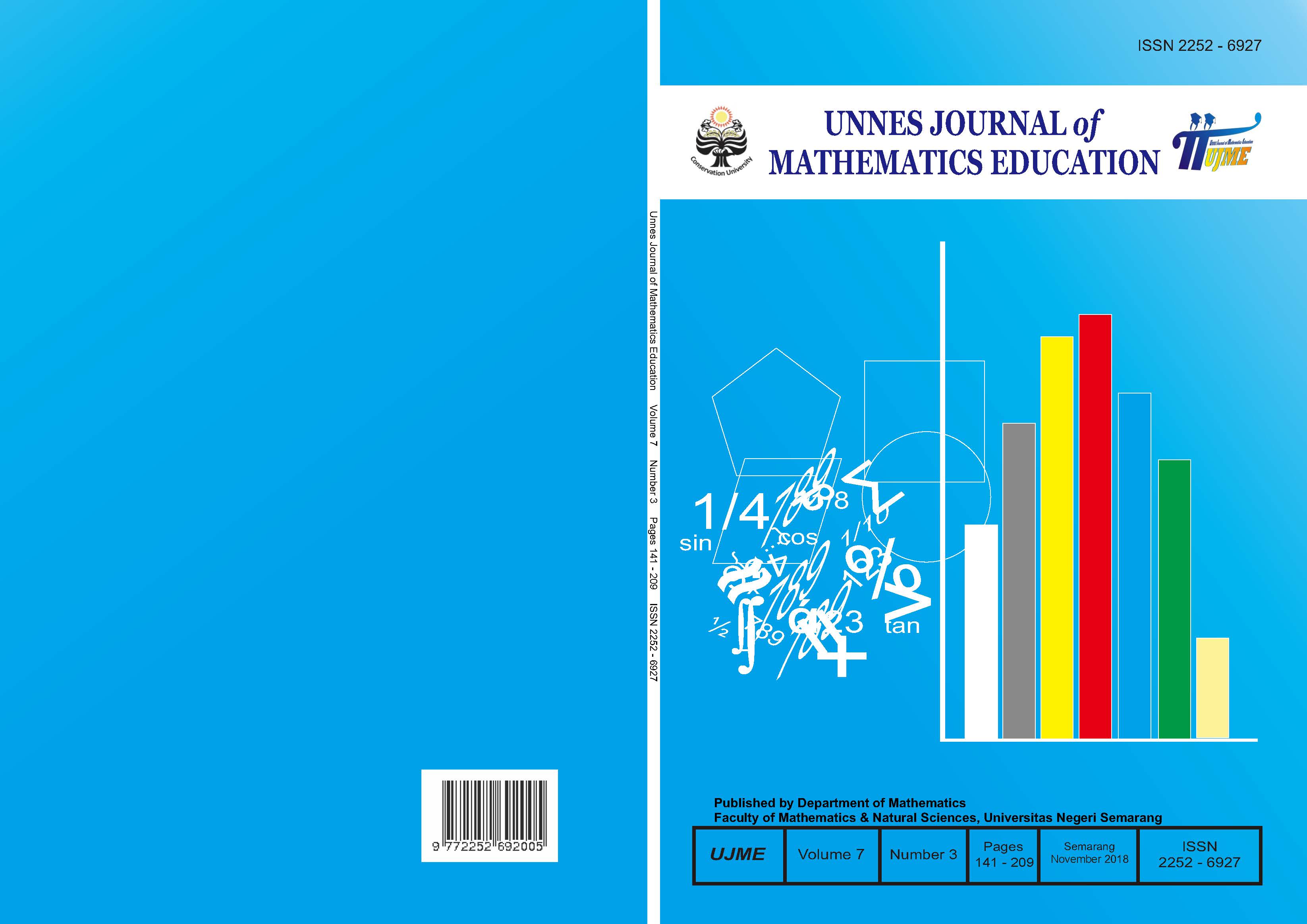The analysis of student’s mathematical communication ability viewed from learning styles through project based learning models on cylinder and cone materials
##plugins.themes.academic_pro.article.main##
Abstract
The aims of this study were to know student’s mathematical communication ability reach minimum criteria of mastery learning, know teacher’s and student’s activity, and describe student’s mathematical communication ability viewed from learning styles. The learning methode used in this study was mix mehod. The population were ninth grader of students from MTsS Hidayatul Athfal Pekalongan and obtained the sample was class IX D as research class. The methods which have been used to collect data were documentation, questionaire, observation, test, and interview. The result in this study show that (1) student’s mathematical communication with Project Based Learning models reach minimum criteria of mastery learning, (2) teacher’s activity on Project Based Learning from first meeting tol fourth meeting was in very good category, (3) student’s activity on Project Based Learning from first meeting tol fourth meeting was in very good category, (4) subject with visual, auditory, and kinesthetic learning styles on the top category were able to fulfill entire mathematical communication indikators. Subject with visual learning styles on the middle category was able to fulfill two indikators. Subject with auditorial and kinesthetic learning styles on the middle category were able to fulfill three indikators. While subject with visual, auditory, and kinesthetic learning styles on the bottom category were able to fulfill just one indikator.
##plugins.themes.academic_pro.article.details##
References
Anintya, Y. A.. (2016). Analysis of mathematical communication skills viewed from student learning styles in eight grader students in learning resource based learning model. Unnes Journal of Mathematics Education, 6(1): 37-43.
Asnawati, S. (2017). Peningkatan Kemampuan Komunikasi Matematis Siswa SMP Dengan Pembelajaran Kooperatif Tipe Teams-Gamestournaments. Euclid, 3(2): 561.
Bas, G. (2011). Investigating the effects of project-based learning on students’ academic achievement and attitudes towards English lesson. The online journal of New Horizons in Education, 1(4), 1-15.
Bell, S. (2010). Project-based learning for 21 century: Skills for the future. The Clearing House, 83(2), 39-43.
ChanLin, L. J. (2008). Technology integration applied to project-based leraning in science. Innovations in Education and Teaching International, 45(1), 55-65.
DePorter, B & Hernacki, M. (1992). Quantum leaning: membiasakan belajar nyaman dan menyenangkan. Diterjemahkan oleh Alwiyah. 2008. Bandung: Kaifa.
Guo, S., & Yang, Y. (2012). Project-based learning: an effective approach to link teacher professional development and students learning. Journal of Educational Technology Development and Enchange (JETDE), 5(2), 41-56.
Kemendikbud. (2016). Permendikbud No 21 Tahun 2016 Tentang Standar Isi Pendidikan Dasar dan Menengah. Jakarta: Kemendikbud.
Lujan, H. L., & DiCarlo, S.E. (2006). First-year medical students prefer multiple learning styles. Advances in physilogy education, 30(1), 13-16.
Moleong, L. J. (2010). Metodologi Penelitian Kualitatif. Bandung: PT. Remaja Rosdakarya.
Mousa, N. M. (2014). The importance of learning styles in education. Institute for Learning Styles Journal, 1(2), 19-27.
NCTM. (2000). Principles and standards for school mathematics. Reston VA: NCTM.
Ozbas, S. (2013). the investigation of the learning styles of university students. The Online Journal of New Horizons in Education, 3(1), 53-58.
PISA. (2015). PISA 2015 Results. Tersedia di https://www.oecd.org/pisa/keyfindings/pisa-2015-results-volume-I.pdf.
Prabowo, A. (2013). Pembelajaran berbasis proyek untuk meningkatkan pemahaman mahasiswa atas permasalahan statistika pada perkuliahan studi kasus dan seminar. Kreano, Jurnal Matematika Kreatif-Inovatif, 3(2), 82-90.
Ramelan, P. (2012). Kemampuan Komunikasi Matematis dan Pembelajaran Interaktif. Jurnal Pendidikan Matematika, 1(1), 77-82.
Ravitz, J., Hixson, N., English, M., & Mergendoller, J. (2012). Using project based learning to teach 21st century skills: Findings from a statewide initiative. In American Educational Research Association, Vancouver, Canada (Vol. 16).
Sani, R. A. (2014). Pembelajaran saintifik untuk implementasi kurikulum 2013. Jakarta: Bumi Aksara.
Siwa, I. B., & Muderawan, I. W. (2013). Pengaruh Pembelajaran Berbasis Proyek dalam Pembelajaran Kimia terhadap Keterampilan Proses Sains Ditijau dari Gaya Kognitif Siswa. Jurnal Pendidikan IPA Indonesia, 3(1).
Sugiyono. (2013). Metode Penelitian Kombinasi. Bandung: Penerbit Alfabeta.
Suhana, C. (2014). Konsep Strategi Pembelajaran. Bandung : Refika Aditama.
Sumarmo. (2006). Pembelajaran Keterampilan Membaca pada Sekolah Menengah. Bandung: FPMIPA UPI. Tersedia pada http://www.academia.edu/4609768/Sumarmo_Pembelajaran_Keterampilan_Membaca_Matematika_pada_Siswa_Sekolah_Menengah.
Thomas, J. W. 2000. A review of research on project-based learning. Article. Report prepared for The Autodesk Foundation, 18 May 2009.
Tiffani, H. 2015. Profil Proses Berpikir Siswa SMP dalam Menyelesaikan Soal Perbandingan Berdasarkan Gaya Belajar dan Gaya Kognitif. Jurnal Kependidikan Dasar, 1(1).
